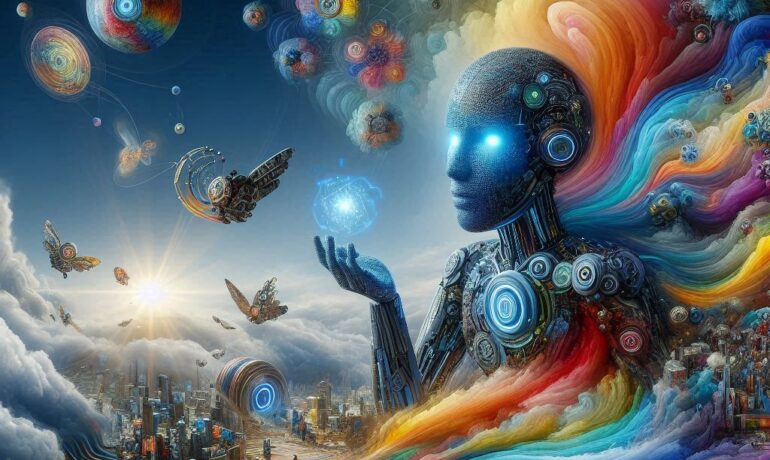Generative AI is ushering in a new era of creativity, empowering machines to produce original content ranging from text and visuals to music and design. Leveraging cutting-edge technologies like Generative Adversarial Networks (GANs) and advanced language models such as GPT, generative AI is not only automating tasks but also pushing the boundaries of innovation. At GM Pacific, we see generative AI as a catalyst for change, transforming industries and reshaping what’s possible in the digital age.
Understanding Generative AI
Generative AI refers to a subset of artificial intelligence that creates new data or content based on patterns it learns from existing datasets. Unlike traditional AI models that focus on classification or analysis, generative AI synthesizes new outputs that mimic human-like creativity.
Some foundational techniques behind generative AI include:
- Generative Adversarial Networks (GANs): A framework with two neural networks—a generator that creates content and a discriminator that evaluates it.
- Transformer Models: Technologies like GPT, which are proficient in processing sequential data to generate coherent and contextually accurate text.
- Variational Autoencoders (VAEs): Often used for image generation, VAEs learn underlying data representations to produce novel variations.
Applications Across Industries
1. Media and Entertainment
Generative AI is revolutionizing the creative processes behind media and entertainment, unlocking unprecedented possibilities.
- Content Generation: AI can draft scripts, develop characters, and design immersive virtual worlds for films, games, and animations.
- Music Production: AI-driven tools compose original music, aiding artists in exploring new styles and genres.
- Deepfake Applications: While controversial, deepfake technology enables the recreation of historical figures and other visual effects for storytelling purposes.
2. Healthcare
In the healthcare sector, generative AI is driving innovation in diagnosis, treatment, and research.
- Drug Discovery: AI models design molecular structures, expediting the identification of promising drug candidates.
- Medical Imaging: AI enhances diagnostic accuracy by creating synthetic datasets to train imaging algorithms.
- Personalized Medicine: By simulating individual patient scenarios, generative AI supports tailored treatment plans.
3. Fashion and Design
Generative AI is redefining creativity in fashion and product design, enabling rapid ideation and customization.
- Virtual Prototyping: AI generates garment prototypes, streamlining the design-to-production process.
- Customer Personalization: Users can co-create custom designs using AI-driven platforms.
- Sustainability Initiatives: AI optimizes material usage, reducing waste and promoting eco-friendly practices.
4. Architecture and Urban Planning
Generative AI is reshaping the way we envision and construct physical spaces.
- Automated Building Designs: AI generates detailed blueprints and 3D models for architectural projects.
- Smart Cities: AI simulates urban layouts to optimize efficiency, livability, and sustainability.
- Interior Design: AI offers personalized recommendations for furniture placement, lighting, and aesthetics.
5. Marketing and Advertising
Generative AI enhances marketing efforts by creating hyper-personalized and engaging content.
- Dynamic Ad Campaigns: AI develops tailored advertisements based on audience insights, maximizing relevance.
- Social Media Management: Tools generate consistent, high-quality posts and visuals to maintain brand engagement.
- Virtual Assistants: AI-powered chatbots provide personalized customer interactions, enhancing user satisfaction.
6. Education and Training
Generative AI is transforming education by making learning more interactive and tailored.
- Customized Learning Materials: AI creates content that aligns with individual learning styles and paces.
- Simulated Training Environments: AI enables virtual scenarios for hands-on training in fields like medicine and aviation.
- Language Practice: Tools like GPT help learners improve linguistic skills through AI-powered conversations.
Benefits of Generative AI
- Enhanced Productivity
Generative AI automates repetitive tasks, freeing professionals to focus on strategy and creativity. - Cost Reduction
By streamlining workflows, generative AI reduces production costs across industries. - Scalable Innovation
Generative models enable rapid experimentation and prototyping, driving faster innovation. - Personalization
AI generates tailored solutions that meet the unique needs of users and businesses.
Challenges of Generative AI
While generative AI offers immense potential, it comes with its own set of challenges:
- Ethical Concerns
- The misuse of AI, such as creating deepfakes or disinformation, raises ethical questions.
- Clear policies and safeguards are essential to ensure responsible use.
- Intellectual Property Issues
- Determining ownership of AI-generated content remains a gray area in copyright law.
- Regulations need to evolve to address these complexities.
- Bias in AI Models
- AI can replicate biases in training data, leading to unfair or discriminatory outputs.
- Organizations must prioritize bias detection and mitigation.
- Quality Control
- Ensuring the accuracy and reliability of AI-generated content requires ongoing validation.
- Human oversight remains vital in critical applications.
The Future of Generative AI
Generative AI is poised to play an even greater role in shaping industries. Key trends to watch include:
- AI-Augmented Creativity: Collaborative tools where humans and AI work together to enhance creativity.
- Real-Time Content Generation: AI systems capable of producing content instantly for live applications.
- Ethical Frameworks: Development of robust guidelines for responsible AI use.
- Generative AI at the Edge: Deploying AI closer to users to enable low-latency applications, such as in gaming or augmented reality.
Conclusion
Generative AI is more than a technological advancement—it’s a transformative force shaping the future of creativity and innovation. By empowering industries to automate, personalize, and scale processes, generative AI is unlocking new possibilities and redefining the limits of human potential. At GM Pacific, we are committed to helping organizations harness the power of generative AI responsibly and effectively.
For more information on how GM Pacific can help your business leverage generative AI, contact us today.
